Performance Evolution: Putting the Brand Budget to Work
Executive Summary
Where is performance marketing now? And where is it going?
In April 2018, TUNE and Acceleration Partners surveyed nearly 2,300 performance marketers in the U.S. and U.K. who are managing a combined $16.6 billion in annual sales.
Survey respondents anticipate that nearly two-thirds of traditional brand marketing will soon be moving to performance channels. This clear indication of confidence and high expectations leads us to a key takeaway: Performance marketing is eating brand marketing.
In 2011, legendary technologist and venture capitalist Marc Andreessen famously said that software was eating the world. Since he helped build the world’s first popular web browser, Mosaic, founded and sold multiple successful companies, and invested in some of Silicon Valley’s top startups, people listened.
His point? Simply that software was taking over as the basis of value creation.
A similar phenomenon is occurring in performance marketing, which is dramatically expanding its influence in 2018.
In 2015, performance marketing drove 14% of all e-commerce transactions in the United States. In 2016, it was responsible for 16% of e-commerce … and Forrester says the space will see a 10% compound annual growth rate until 2020. For a fairly mature industry, this is rapid growth by any benchmark.
In the following pages, we’ll highlight how performance marketing is influencing enterprise and brand marketing plans, and how you can capitalize on these trends.
Performance is Eating Brand Marketing
Marketing Measurement is Where it Starts
Business guru Peter F. Drucker is credited with crystallizing an essential business insight: “What is measured, improves.”
Measuring marketing has been a challenge since its inception. John Wanamaker famously groused that half the money he spent on advertising was wasted, but unfortunately, he didn’t know which half.
At TUNE, we fundamentally believe that all marketing should be measured.
“We want to help marketers measure all of their marketing not because we love analytics, but because we love performance. When you measure marketing the right way, you know your return on investment. And when you know your return on investment, you know where to allocate future budget.”
- Peter Hamilton, CEO, TUNE
Measurement is wonderful, but it’s not easy.
Unfortunately, some members of the performance and affiliate marketing space have manipulated measurement, and the results are bad for brands, bad for performance marketers, and bad for the entire marketing ecosystem. Cookie stuffing, click spamming, and other forms of attribution fraud obscure true links between marketing causes and sales effects.
On the upside, fraud protection not only exists, but is widespread today. Even more fortunately, the ability to manipulate measurement is increasingly difficult when proper attribution, fraud protection, and careful, trained marketers are able to oversee their performance marketing channels.
All of the above have helped measurement become a standard practice. And that’s driving the growth of performance channels.
“Other digital channels such as display advertising require that you pay in advance for a specific number of impressions. “These up-front costs, combined with the questionable ROI of impression-based advertising, have led marketers to increasingly turn to performance marketing.”
- Robert Glazer, Founder & CEO, Acceleration Partners
62% of Brand/Enterprise Marketing Budget Moving to Performance
The majority of affiliate and performance marketers agree: the space is growing fast.
The majority of survey respondents (70%) have observed that 50% or more of brand and enterprise marketing budget is moving to performance marketing. Survey responses range from 0% of budget (five responses) to 100% of budget (128 responses), with the average across all respondents clocking in at 62% of budget moving to performance.
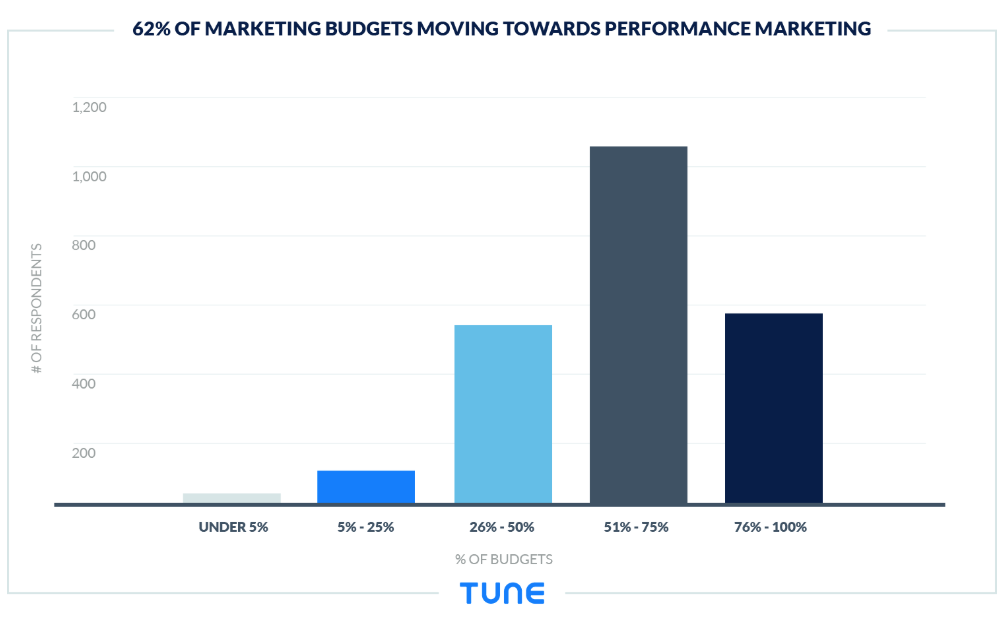
There are good reasons for this growth.
“There is a growing demand for all marketing to be performance-based. Companies are no longer tolerating paying for things and being kept in the dark about what they are getting in return.”
- Laurie Cutts, Head of Partner & Media Channels, Acceleration Partners
Performance Is Out-Competing Brand Marketing
Our research indicates that there are five key reasons for the performance marketing industry’s 10% compound annual growth rate.
The most important? Performance marketing with distributed partners is simply more flexible and expands marketing reach when compared with traditional marketing.
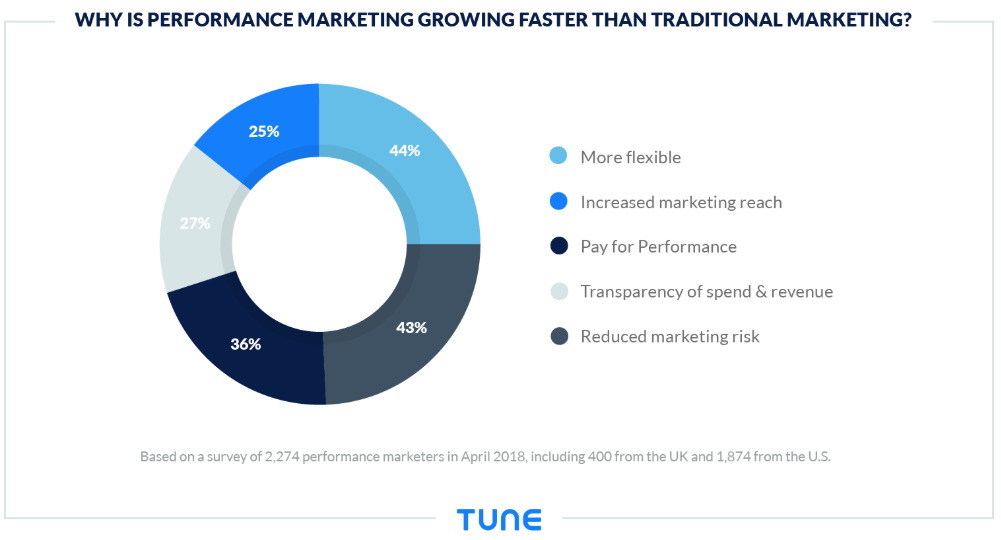
Ultimately, the performance partnership model is easier to scale and increase reach quickly, and the pay-for-performance mechanism inherent to affiliate marketing ensures that, with sufficient oversight and fraud protections, brands and retailers are able to vastly reduce marketing risk.
2018: State of Performance Marketing
What did we learn about performance marketers who work in the field today?
Performance Marketers Work Across the Entire Marketing Ecosystem
A decade ago, affiliate marketing may have lived in the basement, the coffee shop, or the shabby little office on the wrong side of the tracks.
Today, performance marketers are everywhere, in every niche of the marketing ecosystem. A quarter work in agencies, another quarter work directly for brands, and approximately 16% work with ad networks that enable performance partnership marketing at scale.
The biggest group?
Thanks to the prevalence of software-as-a-service, almost 31% work for marketing technology companies: marketing platforms.
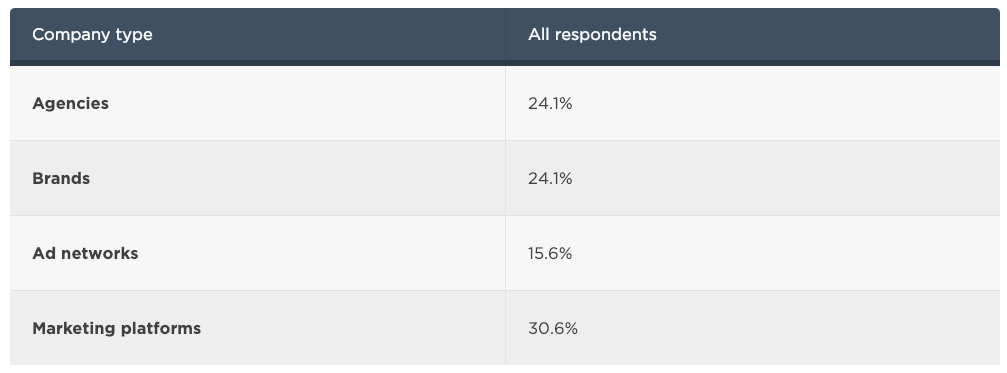
Performance Marketers Typically Work in Small Teams
Despite joining the mainstream marketing ecosystem, performance marketers still tend to work in smaller teams. Among survey respondents, 65% of performance marketers work in teams of 30 people or fewer, and 80% work in teams of 50 people or fewer.
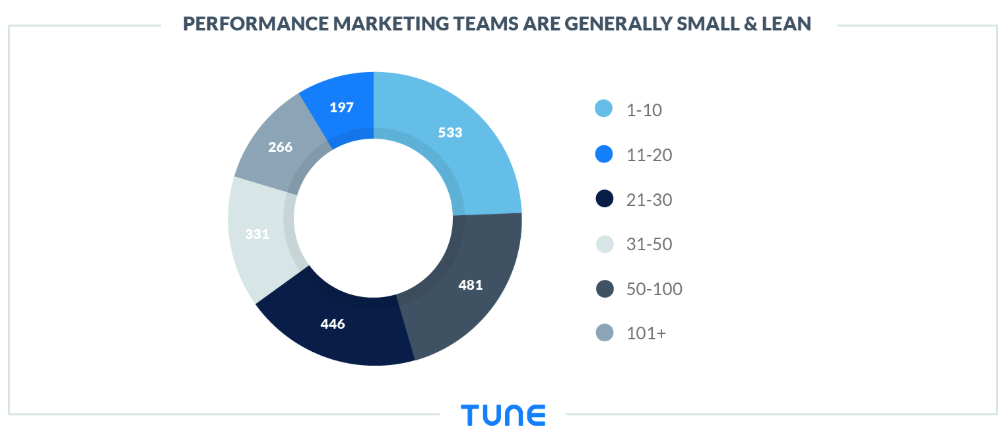
Performance Marketers Drive Significant Revenue
In spite of their relatively small size, performance marketing teams drive significant revenue: $16.6 billion among the 2,300 survey respondents. That being said, large players dominate the space.
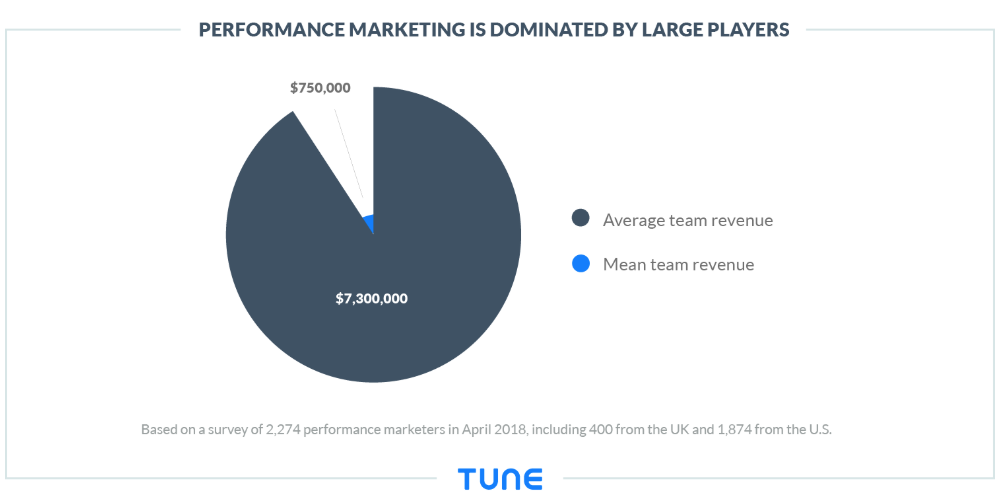
While the average performance marketing team manages $7.3 million in annual revenue, the median number is quite a bit lower: $750,000.
Not surprisingly, it’s larger teams that are driving more revenue.
Almost 70% of teams with fewer than 10 members drive less than $500,000 in annual performance marketing revenue, while about 25% of teams with more than 100 members drive over $50 million in annual performance marketing revenue.
You do not have to be huge to be successful, however. Plenty of teams in the 10 to 30 person range drive about $1 million in annual revenue.
Performance Marketers Work Across Many Verticals
Performance marketers used to confine their focus to a limited number of verticals. E-commerce retail has always part of the picture, as have information, finance, dating, and a few other categories.
Increasingly, however, there’s a wide diversity of verticals that use affiliate marketing, and newer categories, such as subscription services for Netflix, Hulu, or other over-the-top TV providers, are growing fast.
As illustrated below, many marketers work in multiple categories simultaneously, or sequentially.
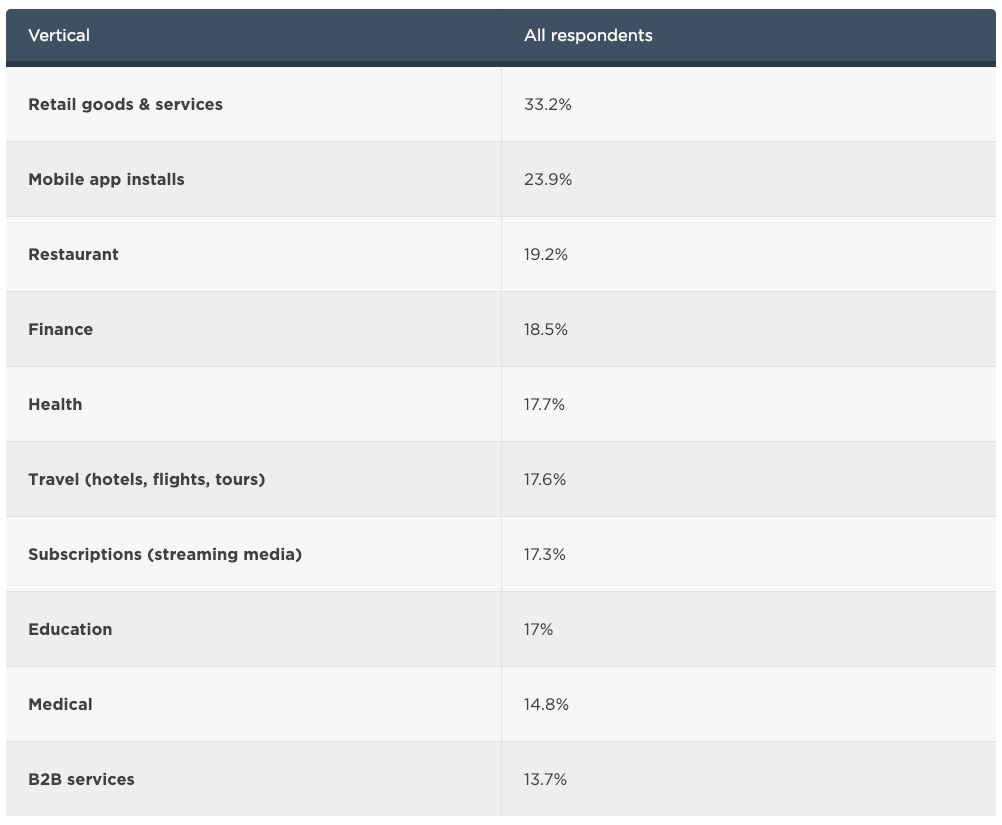
Performance Marketers Partner With Many Services and Channels
Most performance marketers use multiple services and channels to drive demand.
Interestingly, the top three partner types (retail, business development, and loyalty programs) are strongly connected to big brands, retailers, and enterprises. Lead generation services are also often in partnership with large brands.
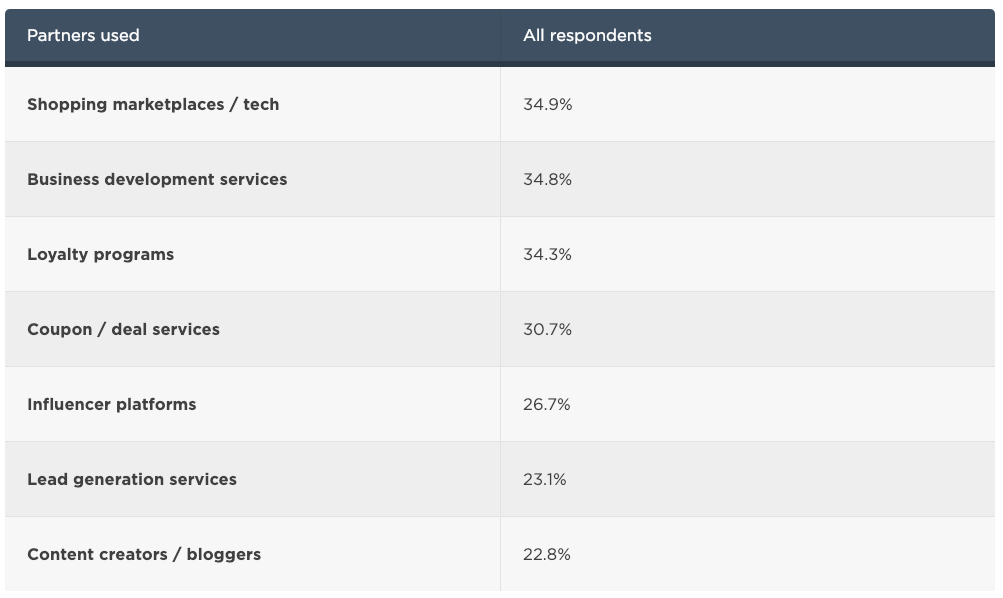
Smart performance marketers use a lot of platforms and place a lot of bets to hit their goals. They’re seldom tied into any one individual partner type, and many use three to five partner types simultaneously.
“Content creators and bloggers are among the most sought-after partnerships for many of Acceleration Partners’ clients. We have clients that focus on building relationships with content partners to increase brand awareness. Even for those brands who have diverse programs with various types of affiliates (coupon, loyalty, etc.), there is still a big focus on content publishers.”
- Laurie Cutts, Head of Partner & Media Channels, Acceleration Partners
Notably, content providers such as Buzzfeed and Business Insider are joining the game, becoming affiliates that are particularly attractive to brands thanks to their large reach, says Cutts.
In terms of specific marketing channels, there’s a lot of diversity as well.
Performance marketers use multiple channels to achieve their goals. Social media and mobile (both apps and web) continue to dominate. And, since social and email are mostly mobile … it’s clear that mobile is where most of the action is.
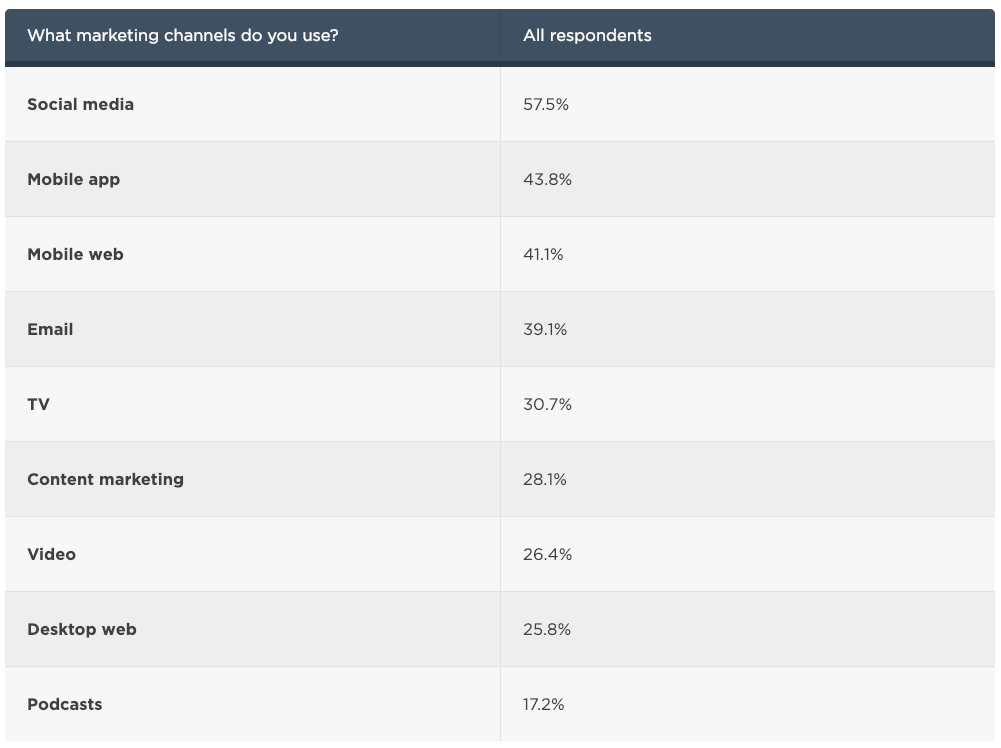
Performance Marketers Partner With Many Services and Channels
While there’s little doubt that last click is still the most-used attribution model, performance marketers are trying multiple models on for size.
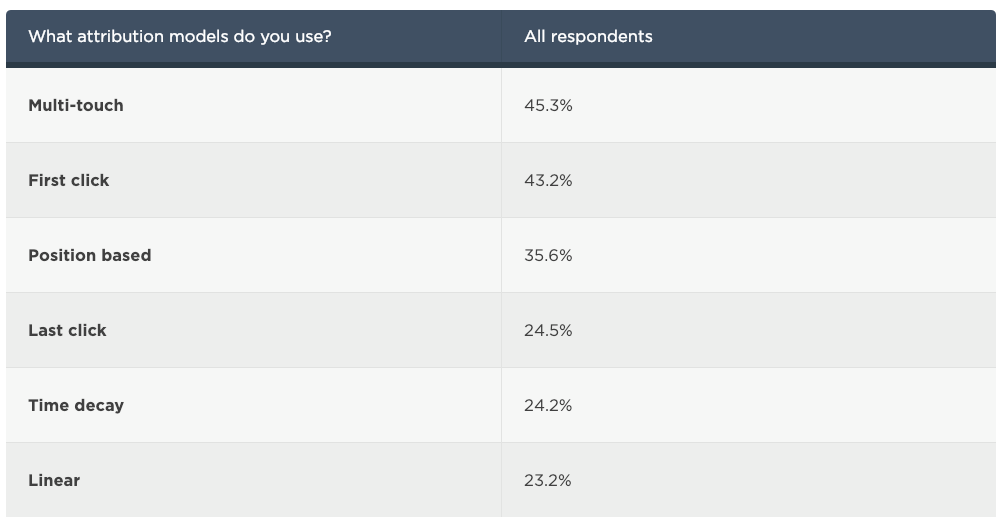
“We are increasingly seeing brands using first click, position-based and multi-touch models for commissioning their affiliates. This is especially true for retailers that work with content partners."
- Laurie Cutts, Head of Partner & Media Channels, Acceleration Partners
Optimizing for Success Today
There are a few clear takeaways from this data that highlight what successful affiliate and performance marketers are doing today.
Connected to Brand Marketing
Performance marketers are connecting to brand marketing more and more. This makes a ton of sense, and we’ve seen marketers boost ROI up to a staggering 1,000% by combining paid, earned, and owned media.
Approximately 68% of performance marketers always or often plan performance campaigns in conjunction with organic marketing such as PR, influencer, and content marketing campaigns. This is critical, because organic and paid campaigns perform better together: each synergistically improves the other, and often 1 + 1 = 3.
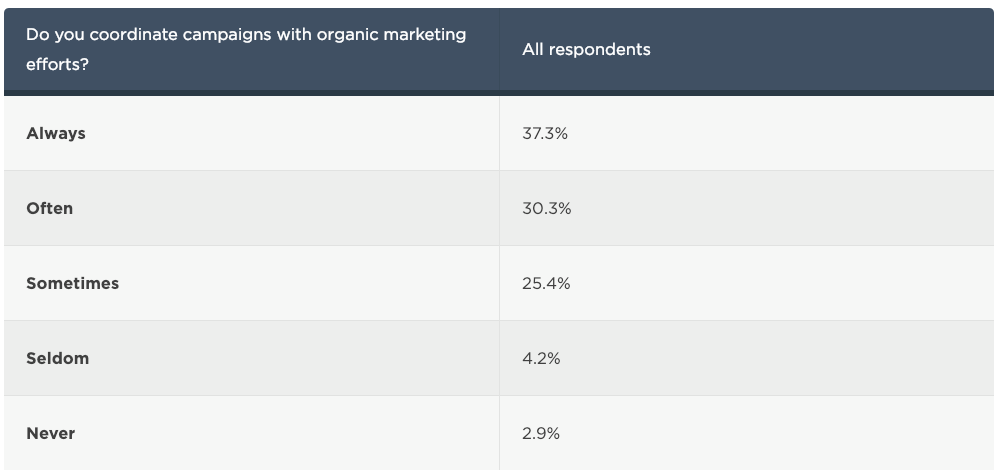
Unsuccessful affiliate marketers coordinate efforts least often with organic marketing teams.
Alternatively, 69.3% of the most successful performance marketers — those who drive $20 million and higher in annual sales — always or often work hand-in-hand with organic marketing initiatives.
Focusing on Global
Brands are thinking globally and performance marketers are following by not just running campaigns in their own country … or even continent.
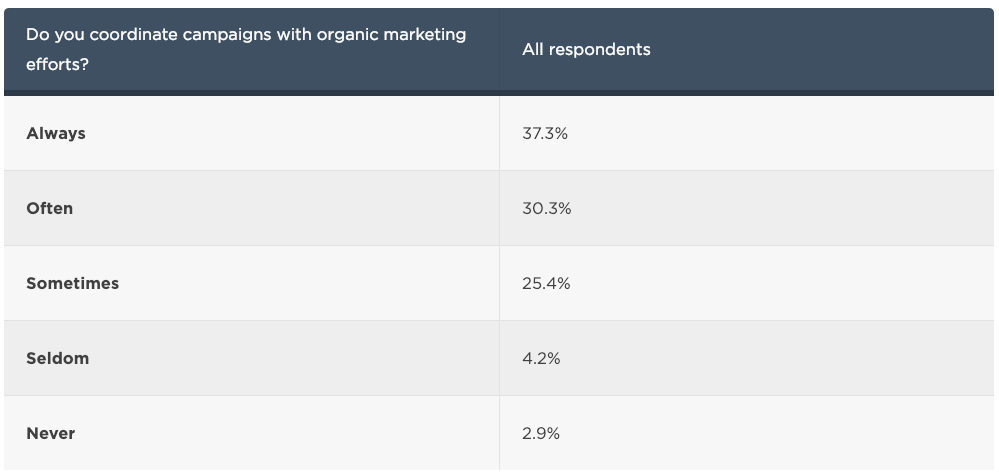
Mobile Is Becoming the Default
Increasingly, mobile is the default mode of consumption for anything digital. Affiliate marketers are a little behind the curve here, but catching up quickly.
Overall, only 62% of all performance marketing offers — coupons, promotions, banners, or even long-form content — are mobile-optimized.
That’s somewhat surprising, given that social media, mobile apps, mobile web, and email are the top four channels respondents are using … and two are completely mobile, while the other two are mostly mobile.
But it’s understandable given that affiliate marketing came of age in the desktop web era — and that models of measurement and tracking can be more challenging in mobile apps than on the web.
It’s clear there’s some work to do here yet.
Working Smarter, Not Harder
One thing that becomes extremely obvious when looking at performance marketing: teams are small and lean, and that has implications. A critical one: placing more importance on using great technology with automation tools and strong partner management functionality.
We’re not talking exactly “set it and forget it,” of course.
Performance marketers will always need to pay attention to their campaigns, their metrics, and their partners. But given the time constraints many performance marketers have, affiliate management tools that automate fraud detection, capping and spend limits, and automatically optimize campaigns, can significantly help.
These enable smart teams to focus on relationships, partnerships, and creative execution, rather than all the metrics every hour of the day.
Future: Where Performance Marketing is Going
Performance Brands
It’s clear that brands are taking performance marketing into places it hasn’t been before.
A quarter of the performance marketers we surveyed are working directly for brands. Many of the quarter that are working for agencies will manage some of their campaigns for brands.
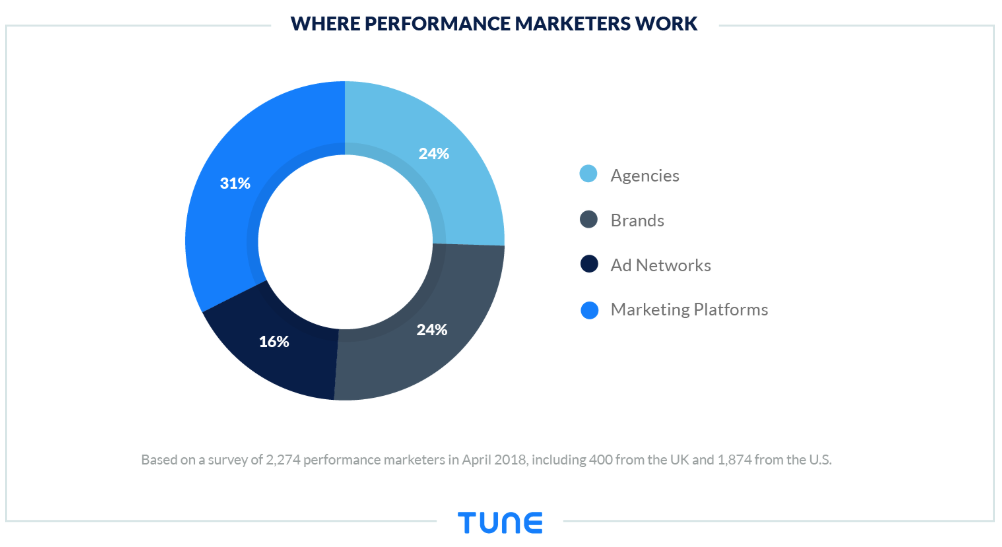
And we’re seeing the change too, at HasOffers. “We’re seeing our customer composition diversify,” says Cameron Stewart, Chief Operating Officer at TUNE.
“Many of our new HasOffers clients are brands using the product internally to manage external teams of marketers. These are global brands who are embracing what Acceleration Partners’ Robert Glazer calls performance partnerships, and it’s an exciting change.”
- Robert Glazer, Founder & CEO, Acceleration Partners
This new relationship allows brands to do what they do best while enlisting the aid of performance marketers who are experts in multiple niches.
“Brands are increasingly leveraging a ‘Marketplaces of Marketing’ model that allows them to partner with a wide range of brand-aligned marketers who focus in specific areas (such as Instagram, content, loyalty, etc.).
This allows brands to partner with experts whose incentives are aligned and who promote their products and services in new and more innovative ways instead of trying to be an expert in every new channel that develops.”
- Robert Glazer, Founder & CEO, Acceleration Partners
Loyalty Programs
One particularly interesting use we’re seeing a lot of recently is brands employing a performance marketing solution like HasOffers to manage their customer loyalty programs.
Rewarding customers for activities that result in new customer acquisition is a no-brainer, but rewarding customers for increasing share of wallet is also part of the mix. Many of these programs are managed internally, but if external partners can help brands, enterprises, and retailers find new ways of delivering more value from existing customers for brands, that unlocked value can be shared.
Interestingly, loyalty programs are the fastest-growing partner type right now, according to the performance marketers we surveyed.

“Brands are increasingly leveraging a ‘Marketplaces of Marketing’ model that allows them to partner with a wide range of brand-aligned marketers who focus in specific areas (such as Instagram, content, loyalty, etc.).
This allows brands to partner with experts whose incentives are aligned and who promote their products and services in new and more innovative ways instead of trying to be an expert in every new channel that develops.”
- Robert Glazer, Founder & CEO, Acceleration Partners
It’s important for brands considering using loyalty programs as part of their affiliate marketing mix to monitor them for truly incremental revenue, whether from existing customers or new customer acquisition, and whether it’s an in-house program or one with external partners.
Loyalty programs can significantly enhance profitability, but programs that are poorly managed, constructed, or monitored can simply result in cannibalization, and therefore reduced margin.
This is just one place where a real relationship — and the right management platform — can help.
“Across all channels, companies are calling for aligned incentives and transparency. They want transparency on what they are paying for and what they can expect in return.”
-Laurie Cutts, Head of Partner & Media Channels, Acceleration Partners
Business Development
Business development programs, once the sole domain of high-end and expensive BD reps, are starting to take advantage of scaled, performance-based partner-driven activities.
Fourth on the list of fastest-growing partner types, business development services use affiliate-style techniques to shake up the slow, expensive world of high-value deals. We see this working especially in the development of two-sided marketplaces, like car sharing services or accommodation platforms.
Marketplaces like these exist to bring demand and supply together, and performance marketing-style business development can help achieve both at scale and at speed.
Influencer Campaigns
Influencer platforms are clearly hot. But they’re only fifth on our list of fastest-growing partner types, which highlights a certain ambivalence in the performance marketing space.
One potential reason is measurement. Or, rather, the lack thereof.
While affiliate marketing lives and dies by measurement, influence campaigns have historically proven challenging to track. In some cases, this is due to platforms — Instagram is the most popular platform for influencers, at least for consumer products, and Instagram’s long-standing lack of linking ability might be part of it. And some influencers have resisted direct measurement, saying that the act of linking removes some of the organic appeal of the micro-celebrity endorsement.
Moving past these issues will be key in enabling influencer marketing — which really, has been around for a very long time under different names — to achieve its full potential.
In fact, the same could be said for virtually any channel.
For more on how marketers and ad networks develop their influencer channel into a valuable and measurable revenue source, watch this webinar recording.
Performance 2020: 5 Key Requirements
Performance marketing has a strong growth record and is continuing to accelerate. But there are five key requirements that brands, enterprises, and performance marketers need to consider to keep that trend going.
1. Fraud Protection
Marketers need to know that they can engage in affiliate and performance marketing initiatives with strong protection against fraud. Advertising fraud and marketing fraud will never be 100% eliminated, but marketers need to be assured that the vast majority of their spend is warranted, safe, and fraud-free.
"The issue of fraud needs to shift to focus on trust. Fraud is reactive; trust is proactive. And trust requires relationship."
-Lucas Brown, Co-Founder, TUNE; Founding Architect, HasOffers
2. Automation & AI
Managing partnerships at scale requires attention to detail and care, but automation can help. Knowing which partners are meeting, exceeding, or failing to meet acceptable parameters is great. Automatically setting levels at which affiliates are warned, turned off, or dialed up is even better.
“As more marketers and more channels adopt performance frameworks, it will be critical for marketing platforms to build in more automation and AI to help marketers make the best decisions at scale.”
- Lucas Brown, Co-Founder, TUNE; Founding Architect, HasOffers
3. Transparency & Openness
We’re long past the days of affiliate marketers operating in the darkness. Brand safety and accountability are critical features of the future of performance marketing.
“CMOs need to know that their brands are safe and sound in the hands of their partners. That can happen only when partnerships are financially aligned, transparent, and communicative. For more scaled relationship management, marketers should use clearly articulated Terms and Conditions supplemented by technology-enabled enforcement to help protect their brands while they grow.”
- Brian Marcus, Global VP of Marketing, TUNE
4. Alignment of Incentives
If performance marketers are simply incentivized to provide traffic, leads, or other top-of-funnel inputs, they will do exactly that. But if they are incentivized to drive actions that result in provable ROI — and can be properly measured to do so — then incentives are aligned between partners and brands.
“Being able to drive performance partnerships in more channels and then evaluate and optimize them for true results will effectively align incentives.”
- Lucas Brown, Co-Founder, TUNE; Founding Architect, HasOffers
5. Owned Platforms
When brands own their platforms, they set the rules. That enables transparency, alignment, and fraud protection. It also ensures that brands don’t pay more than they need to for services rendered.
“Too many companies are paying their marketing partners for inputs when they should be paying for outputs. Performance Partnerships has become the go-to model for growing a brand as it ensures your marketing dollars are being spent in ways that are more transparent, authentic and performance-based.”
- Robert Glazer, Founder & CEO, Acceleration Partners
Read More
To learn more, download the first chapter of Robert Glazer’s book “Performance Partnerships: The Checkered Past, Changing Present, & Exciting Future of Affiliate Marketing.”
Data Used in this Report
TUNE surveyed 2,274 performance marketers in the U.S. and U.K. in March and April of 2018, including 400 in the U.K. and 1,874 in the U.S. Of all respondents, 82% are under the age of 44, 54% are women, and 46% are men.
Measurement and Partner Management Solution to Maximize ROI
TUNE makes technology that powers successful performance-based partnerships across mobile and web. Our flagship product, HasOffers by TUNE, is the industry’s most flexible SaaS solution for tracking, optimizing, and managing mobile-focused affiliate programs. Headquartered in Seattle with hundreds of employees worldwide, TUNE is trusted by innovative affiliate marketers, the largest mobile advertising networks, and iconic brands across the globe.
To try HasOffers free for 30 days. Visit hasoffers.com/pricing to get started.
Author
Becky is the Senior Content Marketing Manager at TUNE. Before TUNE, she led a variety of marketing and communications projects at San Francisco startups. Becky received her bachelor's degree in English from Wake Forest University. After living nearly a decade in San Francisco and Seattle, she has returned to her home of Charleston, SC, where you can find her enjoying the sun and salt water with her family.
